Project Management Report: FIFA 2022 World Cup Tournament Analysis
VerifiedAdded on 2023/04/21
|13
|4262
|59
Report
AI Summary
This report provides a comprehensive analysis of project management strategies applied to the FIFA 2022 World Cup. It begins by exploring different project management processes, focusing on stakeholder management using PMBOK processes, including identification, planning, engagement, and control. The report identifies critical stakeholders and their power and interest levels. It then delves into the implementation of lean project management, outlining principles like waste elimination, value stream determination, customer focus, team member association, and time management. The report elaborates on processes to implement lean project management, emphasizing waste reduction and upfront approaches to ensure project effectiveness. The report concludes by highlighting the importance of stakeholder engagement and effective project execution for the successful delivery of the FIFA 2022 World Cup event.
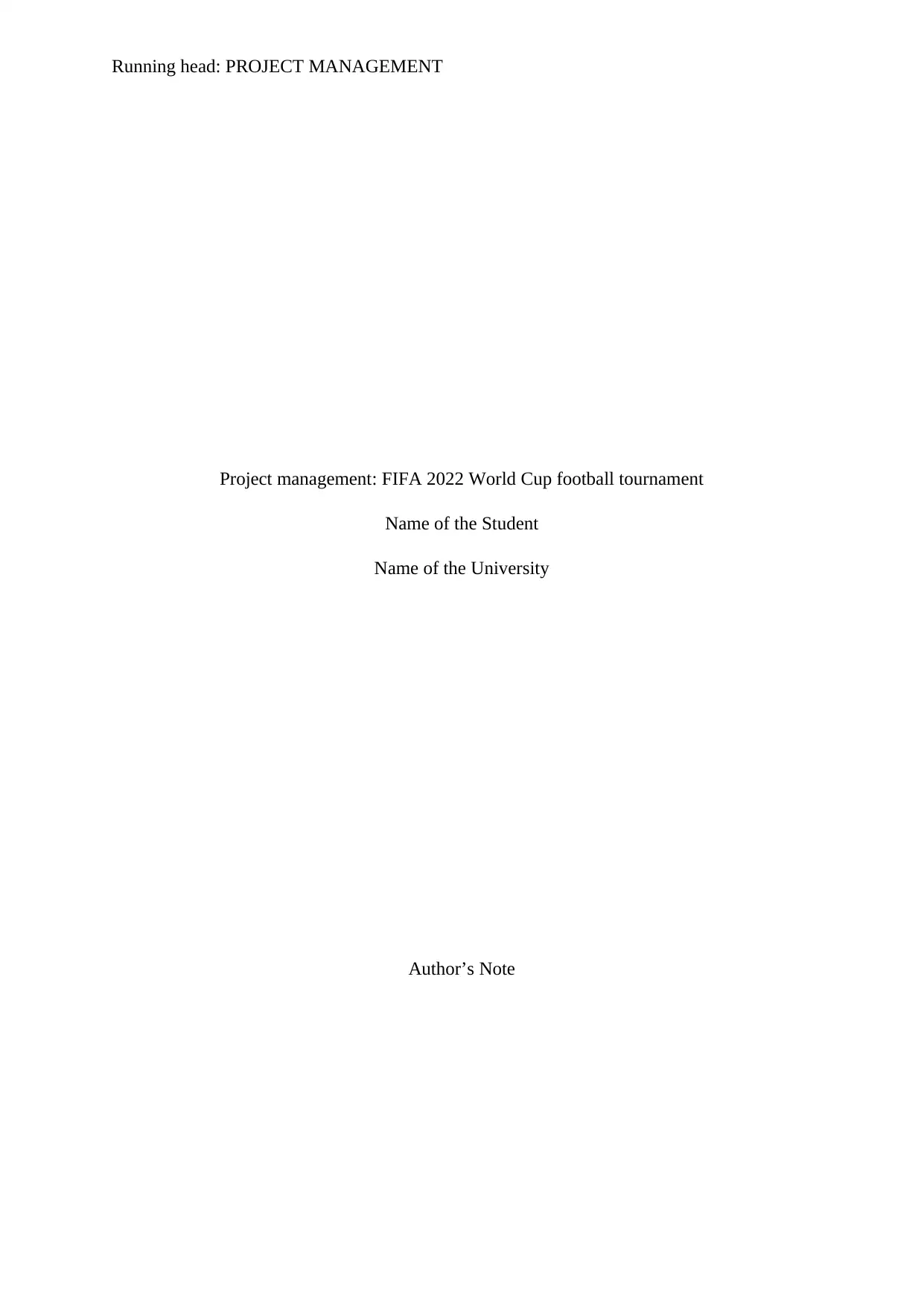
Running head: PROJECT MANAGEMENT
Project management: FIFA 2022 World Cup football tournament
Name of the Student
Name of the University
Author’s Note
Project management: FIFA 2022 World Cup football tournament
Name of the Student
Name of the University
Author’s Note
Paraphrase This Document
Need a fresh take? Get an instant paraphrase of this document with our AI Paraphraser
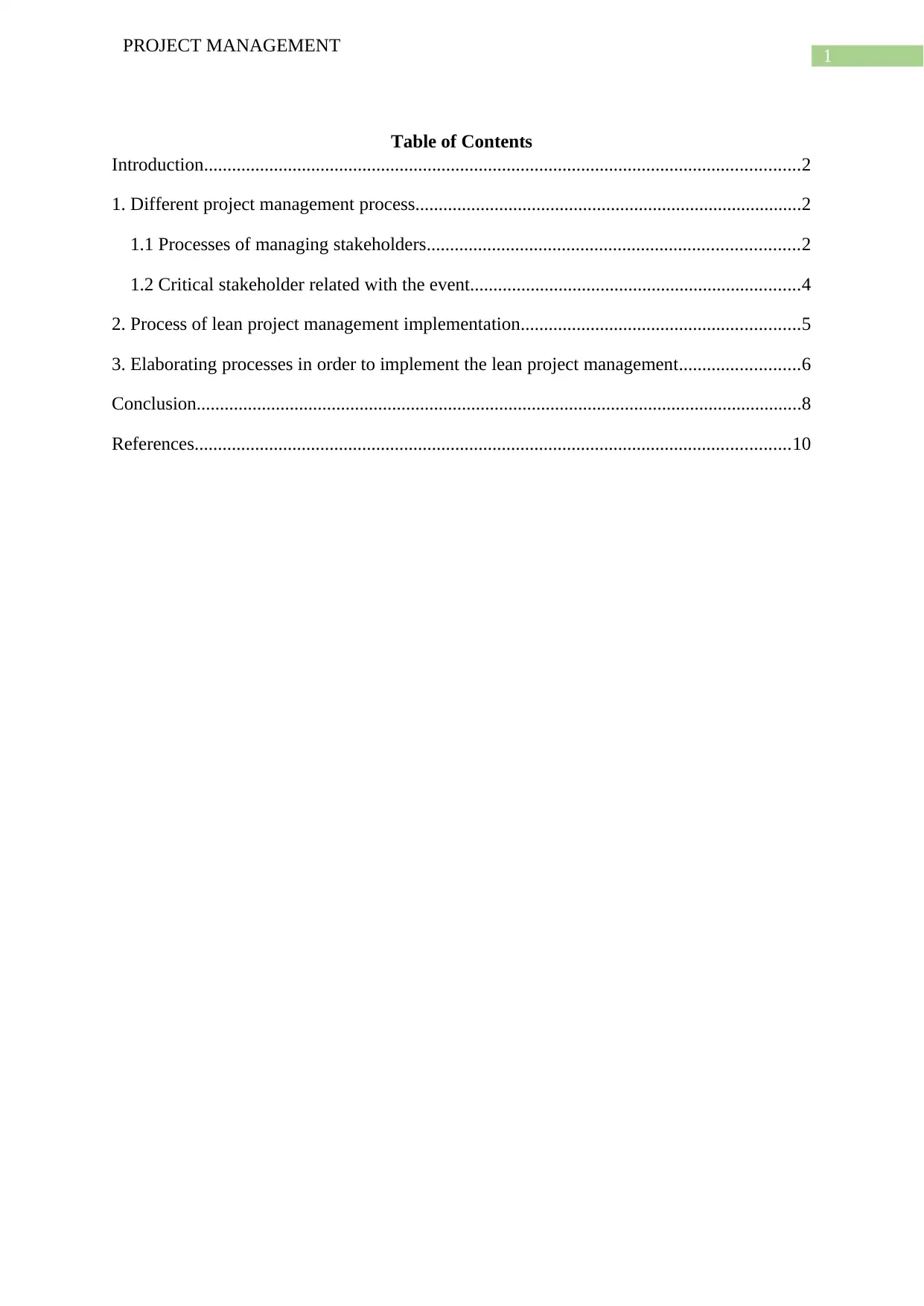
1
PROJECT MANAGEMENT
Table of Contents
Introduction................................................................................................................................2
1. Different project management process...................................................................................2
1.1 Processes of managing stakeholders................................................................................2
1.2 Critical stakeholder related with the event.......................................................................4
2. Process of lean project management implementation............................................................5
3. Elaborating processes in order to implement the lean project management..........................6
Conclusion..................................................................................................................................8
References................................................................................................................................10
PROJECT MANAGEMENT
Table of Contents
Introduction................................................................................................................................2
1. Different project management process...................................................................................2
1.1 Processes of managing stakeholders................................................................................2
1.2 Critical stakeholder related with the event.......................................................................4
2. Process of lean project management implementation............................................................5
3. Elaborating processes in order to implement the lean project management..........................6
Conclusion..................................................................................................................................8
References................................................................................................................................10
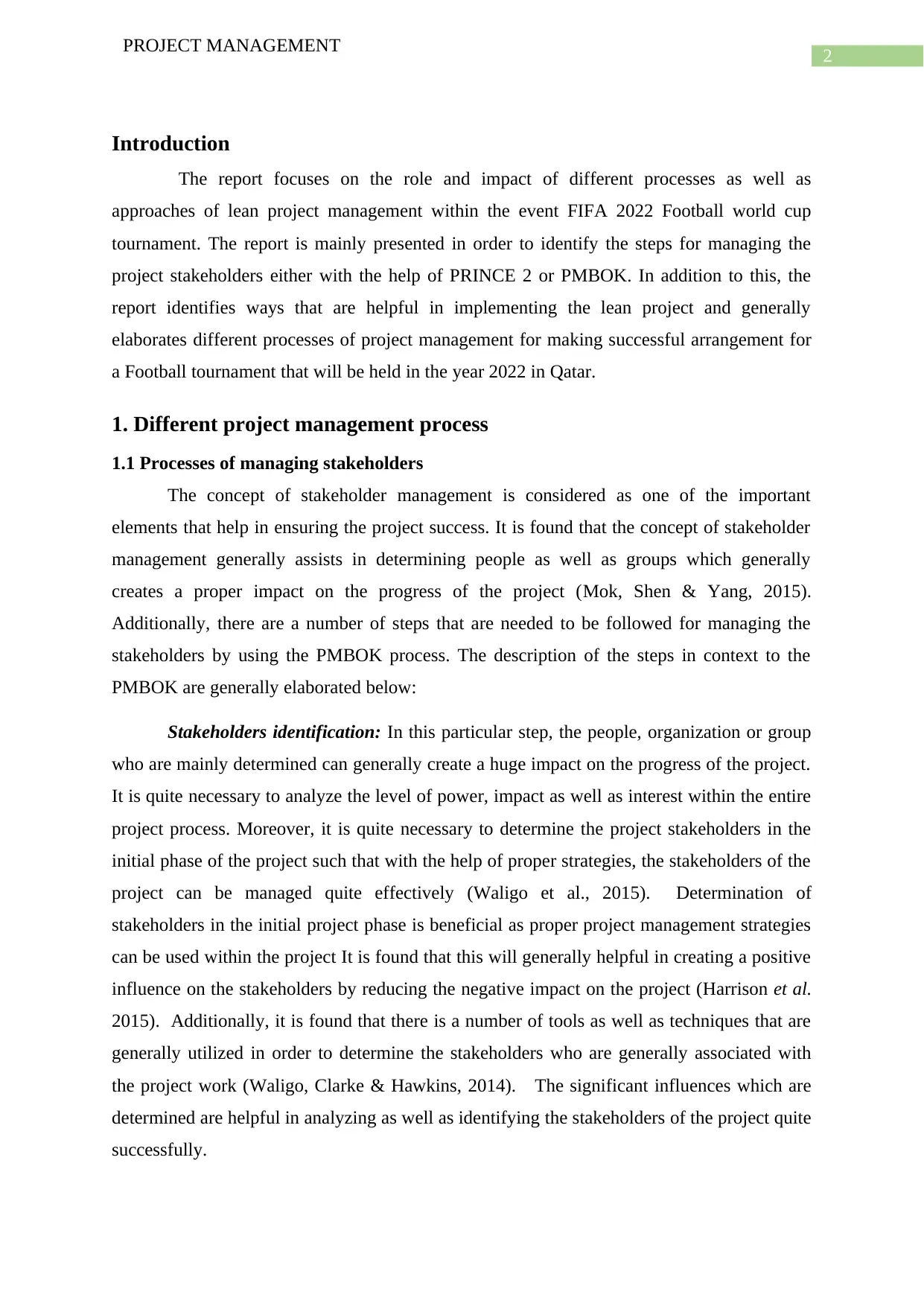
2
PROJECT MANAGEMENT
Introduction
The report focuses on the role and impact of different processes as well as
approaches of lean project management within the event FIFA 2022 Football world cup
tournament. The report is mainly presented in order to identify the steps for managing the
project stakeholders either with the help of PRINCE 2 or PMBOK. In addition to this, the
report identifies ways that are helpful in implementing the lean project and generally
elaborates different processes of project management for making successful arrangement for
a Football tournament that will be held in the year 2022 in Qatar.
1. Different project management process
1.1 Processes of managing stakeholders
The concept of stakeholder management is considered as one of the important
elements that help in ensuring the project success. It is found that the concept of stakeholder
management generally assists in determining people as well as groups which generally
creates a proper impact on the progress of the project (Mok, Shen & Yang, 2015).
Additionally, there are a number of steps that are needed to be followed for managing the
stakeholders by using the PMBOK process. The description of the steps in context to the
PMBOK are generally elaborated below:
Stakeholders identification: In this particular step, the people, organization or group
who are mainly determined can generally create a huge impact on the progress of the project.
It is quite necessary to analyze the level of power, impact as well as interest within the entire
project process. Moreover, it is quite necessary to determine the project stakeholders in the
initial phase of the project such that with the help of proper strategies, the stakeholders of the
project can be managed quite effectively (Waligo et al., 2015). Determination of
stakeholders in the initial project phase is beneficial as proper project management strategies
can be used within the project It is found that this will generally helpful in creating a positive
influence on the stakeholders by reducing the negative impact on the project (Harrison et al.
2015). Additionally, it is found that there is a number of tools as well as techniques that are
generally utilized in order to determine the stakeholders who are generally associated with
the project work (Waligo, Clarke & Hawkins, 2014). The significant influences which are
determined are helpful in analyzing as well as identifying the stakeholders of the project quite
successfully.
PROJECT MANAGEMENT
Introduction
The report focuses on the role and impact of different processes as well as
approaches of lean project management within the event FIFA 2022 Football world cup
tournament. The report is mainly presented in order to identify the steps for managing the
project stakeholders either with the help of PRINCE 2 or PMBOK. In addition to this, the
report identifies ways that are helpful in implementing the lean project and generally
elaborates different processes of project management for making successful arrangement for
a Football tournament that will be held in the year 2022 in Qatar.
1. Different project management process
1.1 Processes of managing stakeholders
The concept of stakeholder management is considered as one of the important
elements that help in ensuring the project success. It is found that the concept of stakeholder
management generally assists in determining people as well as groups which generally
creates a proper impact on the progress of the project (Mok, Shen & Yang, 2015).
Additionally, there are a number of steps that are needed to be followed for managing the
stakeholders by using the PMBOK process. The description of the steps in context to the
PMBOK are generally elaborated below:
Stakeholders identification: In this particular step, the people, organization or group
who are mainly determined can generally create a huge impact on the progress of the project.
It is quite necessary to analyze the level of power, impact as well as interest within the entire
project process. Moreover, it is quite necessary to determine the project stakeholders in the
initial phase of the project such that with the help of proper strategies, the stakeholders of the
project can be managed quite effectively (Waligo et al., 2015). Determination of
stakeholders in the initial project phase is beneficial as proper project management strategies
can be used within the project It is found that this will generally helpful in creating a positive
influence on the stakeholders by reducing the negative impact on the project (Harrison et al.
2015). Additionally, it is found that there is a number of tools as well as techniques that are
generally utilized in order to determine the stakeholders who are generally associated with
the project work (Waligo, Clarke & Hawkins, 2014). The significant influences which are
determined are helpful in analyzing as well as identifying the stakeholders of the project quite
successfully.
⊘ This is a preview!⊘
Do you want full access?
Subscribe today to unlock all pages.

Trusted by 1+ million students worldwide
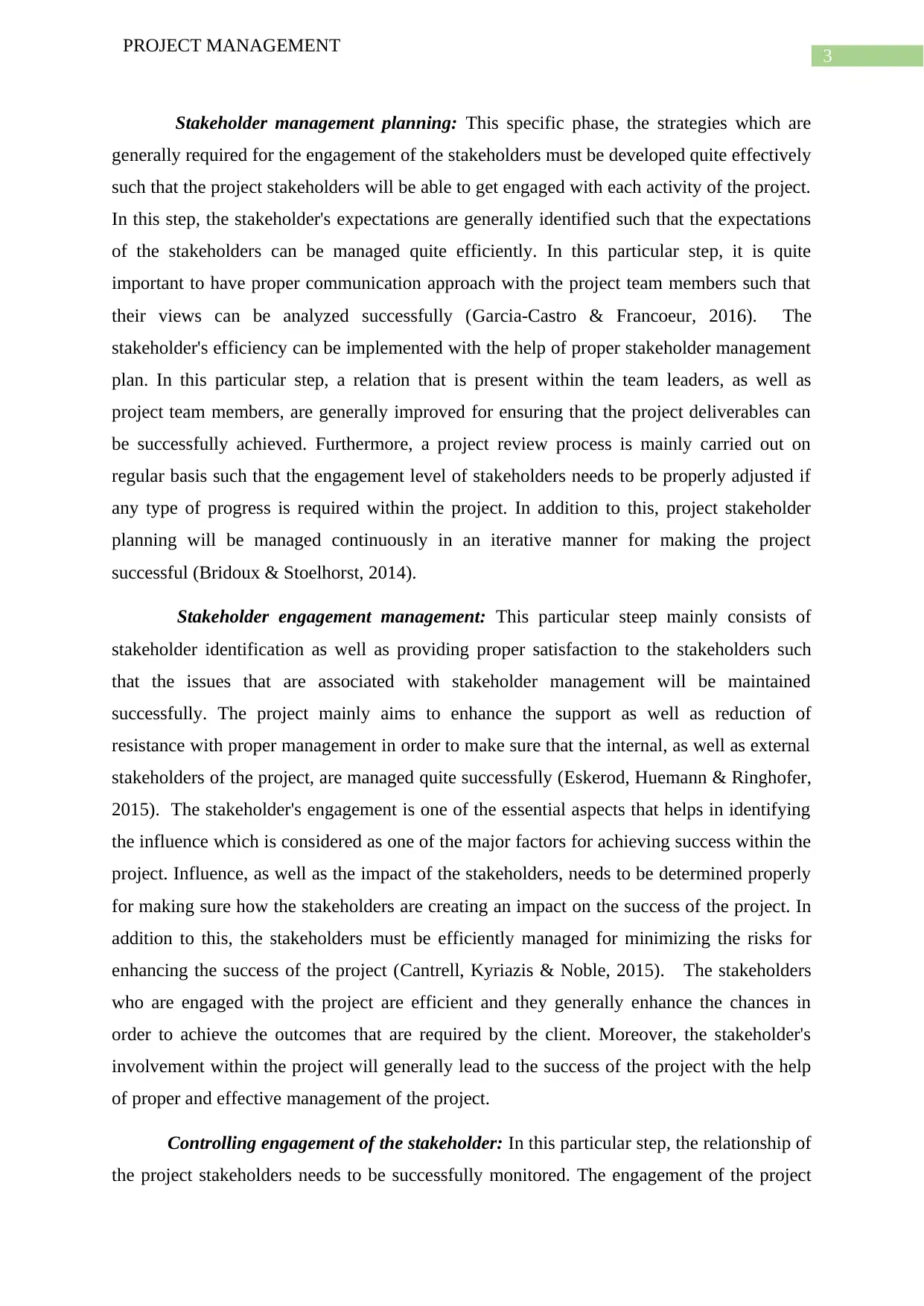
3
PROJECT MANAGEMENT
Stakeholder management planning: This specific phase, the strategies which are
generally required for the engagement of the stakeholders must be developed quite effectively
such that the project stakeholders will be able to get engaged with each activity of the project.
In this step, the stakeholder's expectations are generally identified such that the expectations
of the stakeholders can be managed quite efficiently. In this particular step, it is quite
important to have proper communication approach with the project team members such that
their views can be analyzed successfully (Garcia‐Castro & Francoeur, 2016). The
stakeholder's efficiency can be implemented with the help of proper stakeholder management
plan. In this particular step, a relation that is present within the team leaders, as well as
project team members, are generally improved for ensuring that the project deliverables can
be successfully achieved. Furthermore, a project review process is mainly carried out on
regular basis such that the engagement level of stakeholders needs to be properly adjusted if
any type of progress is required within the project. In addition to this, project stakeholder
planning will be managed continuously in an iterative manner for making the project
successful (Bridoux & Stoelhorst, 2014).
Stakeholder engagement management: This particular steep mainly consists of
stakeholder identification as well as providing proper satisfaction to the stakeholders such
that the issues that are associated with stakeholder management will be maintained
successfully. The project mainly aims to enhance the support as well as reduction of
resistance with proper management in order to make sure that the internal, as well as external
stakeholders of the project, are managed quite successfully (Eskerod, Huemann & Ringhofer,
2015). The stakeholder's engagement is one of the essential aspects that helps in identifying
the influence which is considered as one of the major factors for achieving success within the
project. Influence, as well as the impact of the stakeholders, needs to be determined properly
for making sure how the stakeholders are creating an impact on the success of the project. In
addition to this, the stakeholders must be efficiently managed for minimizing the risks for
enhancing the success of the project (Cantrell, Kyriazis & Noble, 2015). The stakeholders
who are engaged with the project are efficient and they generally enhance the chances in
order to achieve the outcomes that are required by the client. Moreover, the stakeholder's
involvement within the project will generally lead to the success of the project with the help
of proper and effective management of the project.
Controlling engagement of the stakeholder: In this particular step, the relationship of
the project stakeholders needs to be successfully monitored. The engagement of the project
PROJECT MANAGEMENT
Stakeholder management planning: This specific phase, the strategies which are
generally required for the engagement of the stakeholders must be developed quite effectively
such that the project stakeholders will be able to get engaged with each activity of the project.
In this step, the stakeholder's expectations are generally identified such that the expectations
of the stakeholders can be managed quite efficiently. In this particular step, it is quite
important to have proper communication approach with the project team members such that
their views can be analyzed successfully (Garcia‐Castro & Francoeur, 2016). The
stakeholder's efficiency can be implemented with the help of proper stakeholder management
plan. In this particular step, a relation that is present within the team leaders, as well as
project team members, are generally improved for ensuring that the project deliverables can
be successfully achieved. Furthermore, a project review process is mainly carried out on
regular basis such that the engagement level of stakeholders needs to be properly adjusted if
any type of progress is required within the project. In addition to this, project stakeholder
planning will be managed continuously in an iterative manner for making the project
successful (Bridoux & Stoelhorst, 2014).
Stakeholder engagement management: This particular steep mainly consists of
stakeholder identification as well as providing proper satisfaction to the stakeholders such
that the issues that are associated with stakeholder management will be maintained
successfully. The project mainly aims to enhance the support as well as reduction of
resistance with proper management in order to make sure that the internal, as well as external
stakeholders of the project, are managed quite successfully (Eskerod, Huemann & Ringhofer,
2015). The stakeholder's engagement is one of the essential aspects that helps in identifying
the influence which is considered as one of the major factors for achieving success within the
project. Influence, as well as the impact of the stakeholders, needs to be determined properly
for making sure how the stakeholders are creating an impact on the success of the project. In
addition to this, the stakeholders must be efficiently managed for minimizing the risks for
enhancing the success of the project (Cantrell, Kyriazis & Noble, 2015). The stakeholders
who are engaged with the project are efficient and they generally enhance the chances in
order to achieve the outcomes that are required by the client. Moreover, the stakeholder's
involvement within the project will generally lead to the success of the project with the help
of proper and effective management of the project.
Controlling engagement of the stakeholder: In this particular step, the relationship of
the project stakeholders needs to be successfully monitored. The engagement of the project
Paraphrase This Document
Need a fresh take? Get an instant paraphrase of this document with our AI Paraphraser
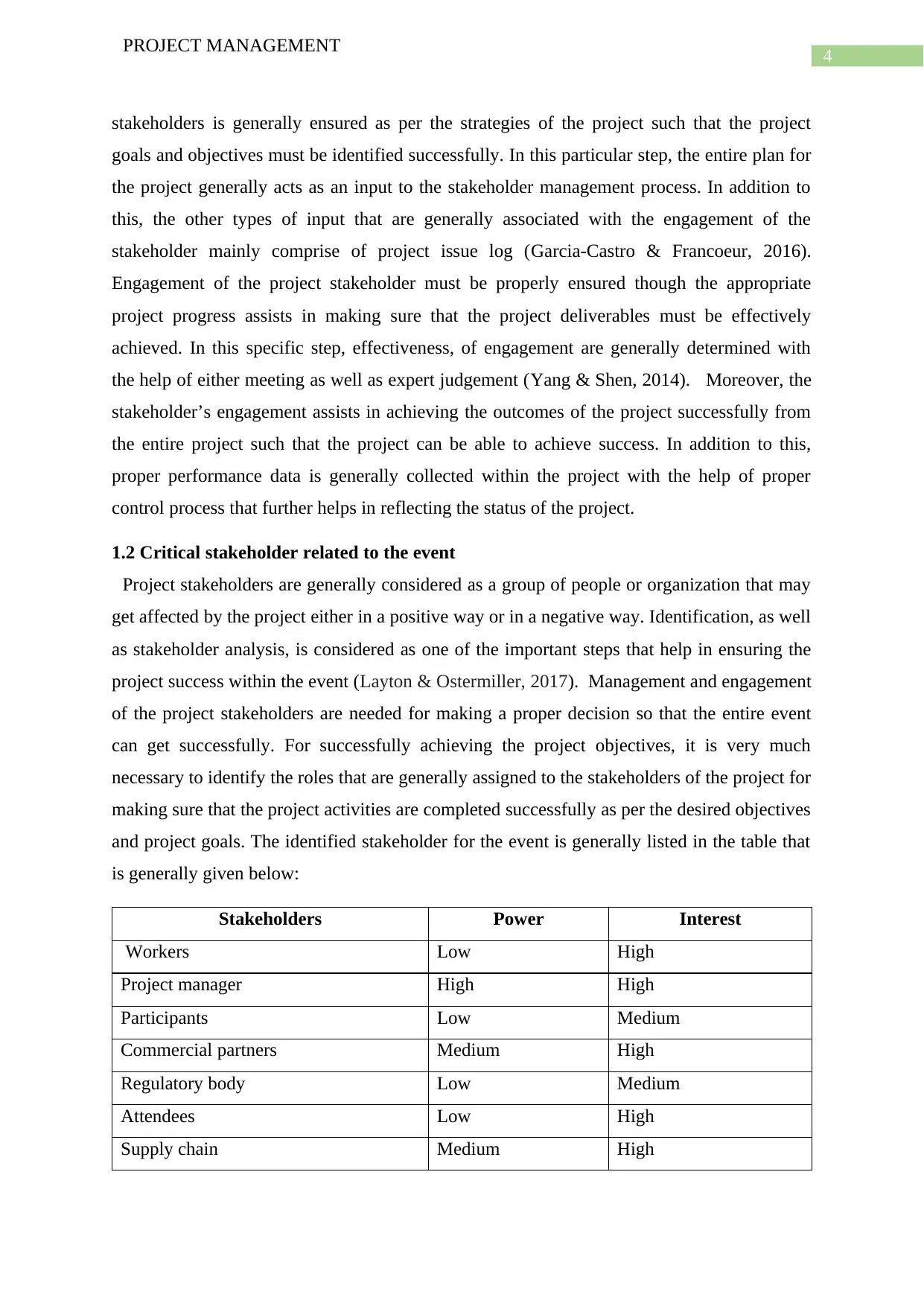
4
PROJECT MANAGEMENT
stakeholders is generally ensured as per the strategies of the project such that the project
goals and objectives must be identified successfully. In this particular step, the entire plan for
the project generally acts as an input to the stakeholder management process. In addition to
this, the other types of input that are generally associated with the engagement of the
stakeholder mainly comprise of project issue log (Garcia‐Castro & Francoeur, 2016).
Engagement of the project stakeholder must be properly ensured though the appropriate
project progress assists in making sure that the project deliverables must be effectively
achieved. In this specific step, effectiveness, of engagement are generally determined with
the help of either meeting as well as expert judgement (Yang & Shen, 2014). Moreover, the
stakeholder’s engagement assists in achieving the outcomes of the project successfully from
the entire project such that the project can be able to achieve success. In addition to this,
proper performance data is generally collected within the project with the help of proper
control process that further helps in reflecting the status of the project.
1.2 Critical stakeholder related to the event
Project stakeholders are generally considered as a group of people or organization that may
get affected by the project either in a positive way or in a negative way. Identification, as well
as stakeholder analysis, is considered as one of the important steps that help in ensuring the
project success within the event (Layton & Ostermiller, 2017). Management and engagement
of the project stakeholders are needed for making a proper decision so that the entire event
can get successfully. For successfully achieving the project objectives, it is very much
necessary to identify the roles that are generally assigned to the stakeholders of the project for
making sure that the project activities are completed successfully as per the desired objectives
and project goals. The identified stakeholder for the event is generally listed in the table that
is generally given below:
Stakeholders Power Interest
Workers Low High
Project manager High High
Participants Low Medium
Commercial partners Medium High
Regulatory body Low Medium
Attendees Low High
Supply chain Medium High
PROJECT MANAGEMENT
stakeholders is generally ensured as per the strategies of the project such that the project
goals and objectives must be identified successfully. In this particular step, the entire plan for
the project generally acts as an input to the stakeholder management process. In addition to
this, the other types of input that are generally associated with the engagement of the
stakeholder mainly comprise of project issue log (Garcia‐Castro & Francoeur, 2016).
Engagement of the project stakeholder must be properly ensured though the appropriate
project progress assists in making sure that the project deliverables must be effectively
achieved. In this specific step, effectiveness, of engagement are generally determined with
the help of either meeting as well as expert judgement (Yang & Shen, 2014). Moreover, the
stakeholder’s engagement assists in achieving the outcomes of the project successfully from
the entire project such that the project can be able to achieve success. In addition to this,
proper performance data is generally collected within the project with the help of proper
control process that further helps in reflecting the status of the project.
1.2 Critical stakeholder related to the event
Project stakeholders are generally considered as a group of people or organization that may
get affected by the project either in a positive way or in a negative way. Identification, as well
as stakeholder analysis, is considered as one of the important steps that help in ensuring the
project success within the event (Layton & Ostermiller, 2017). Management and engagement
of the project stakeholders are needed for making a proper decision so that the entire event
can get successfully. For successfully achieving the project objectives, it is very much
necessary to identify the roles that are generally assigned to the stakeholders of the project for
making sure that the project activities are completed successfully as per the desired objectives
and project goals. The identified stakeholder for the event is generally listed in the table that
is generally given below:
Stakeholders Power Interest
Workers Low High
Project manager High High
Participants Low Medium
Commercial partners Medium High
Regulatory body Low Medium
Attendees Low High
Supply chain Medium High
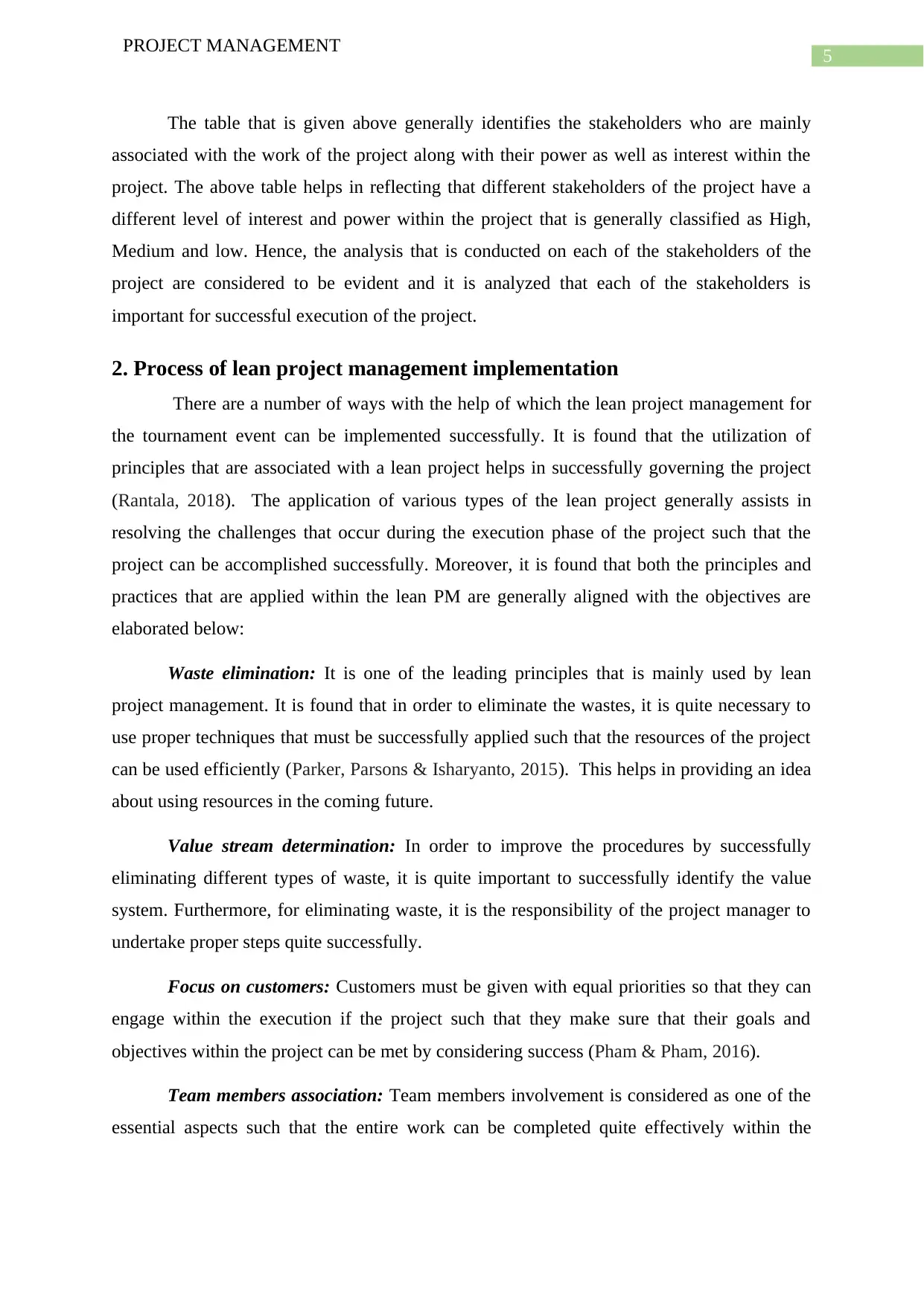
5
PROJECT MANAGEMENT
The table that is given above generally identifies the stakeholders who are mainly
associated with the work of the project along with their power as well as interest within the
project. The above table helps in reflecting that different stakeholders of the project have a
different level of interest and power within the project that is generally classified as High,
Medium and low. Hence, the analysis that is conducted on each of the stakeholders of the
project are considered to be evident and it is analyzed that each of the stakeholders is
important for successful execution of the project.
2. Process of lean project management implementation
There are a number of ways with the help of which the lean project management for
the tournament event can be implemented successfully. It is found that the utilization of
principles that are associated with a lean project helps in successfully governing the project
(Rantala, 2018). The application of various types of the lean project generally assists in
resolving the challenges that occur during the execution phase of the project such that the
project can be accomplished successfully. Moreover, it is found that both the principles and
practices that are applied within the lean PM are generally aligned with the objectives are
elaborated below:
Waste elimination: It is one of the leading principles that is mainly used by lean
project management. It is found that in order to eliminate the wastes, it is quite necessary to
use proper techniques that must be successfully applied such that the resources of the project
can be used efficiently (Parker, Parsons & Isharyanto, 2015). This helps in providing an idea
about using resources in the coming future.
Value stream determination: In order to improve the procedures by successfully
eliminating different types of waste, it is quite important to successfully identify the value
system. Furthermore, for eliminating waste, it is the responsibility of the project manager to
undertake proper steps quite successfully.
Focus on customers: Customers must be given with equal priorities so that they can
engage within the execution if the project such that they make sure that their goals and
objectives within the project can be met by considering success (Pham & Pham, 2016).
Team members association: Team members involvement is considered as one of the
essential aspects such that the entire work can be completed quite effectively within the
PROJECT MANAGEMENT
The table that is given above generally identifies the stakeholders who are mainly
associated with the work of the project along with their power as well as interest within the
project. The above table helps in reflecting that different stakeholders of the project have a
different level of interest and power within the project that is generally classified as High,
Medium and low. Hence, the analysis that is conducted on each of the stakeholders of the
project are considered to be evident and it is analyzed that each of the stakeholders is
important for successful execution of the project.
2. Process of lean project management implementation
There are a number of ways with the help of which the lean project management for
the tournament event can be implemented successfully. It is found that the utilization of
principles that are associated with a lean project helps in successfully governing the project
(Rantala, 2018). The application of various types of the lean project generally assists in
resolving the challenges that occur during the execution phase of the project such that the
project can be accomplished successfully. Moreover, it is found that both the principles and
practices that are applied within the lean PM are generally aligned with the objectives are
elaborated below:
Waste elimination: It is one of the leading principles that is mainly used by lean
project management. It is found that in order to eliminate the wastes, it is quite necessary to
use proper techniques that must be successfully applied such that the resources of the project
can be used efficiently (Parker, Parsons & Isharyanto, 2015). This helps in providing an idea
about using resources in the coming future.
Value stream determination: In order to improve the procedures by successfully
eliminating different types of waste, it is quite important to successfully identify the value
system. Furthermore, for eliminating waste, it is the responsibility of the project manager to
undertake proper steps quite successfully.
Focus on customers: Customers must be given with equal priorities so that they can
engage within the execution if the project such that they make sure that their goals and
objectives within the project can be met by considering success (Pham & Pham, 2016).
Team members association: Team members involvement is considered as one of the
essential aspects such that the entire work can be completed quite effectively within the
⊘ This is a preview!⊘
Do you want full access?
Subscribe today to unlock all pages.

Trusted by 1+ million students worldwide
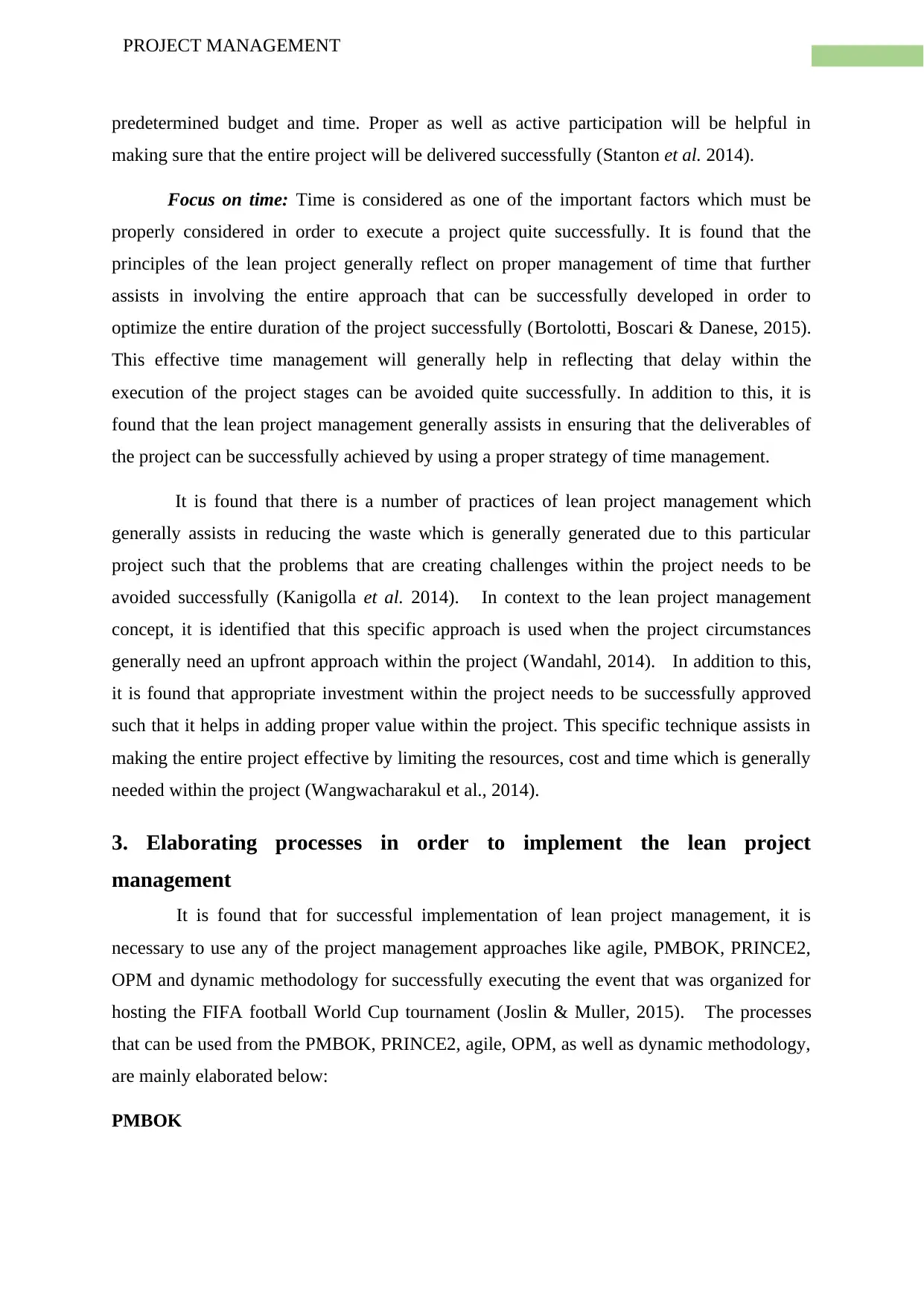
6
PROJECT MANAGEMENT
predetermined budget and time. Proper as well as active participation will be helpful in
making sure that the entire project will be delivered successfully (Stanton et al. 2014).
Focus on time: Time is considered as one of the important factors which must be
properly considered in order to execute a project quite successfully. It is found that the
principles of the lean project generally reflect on proper management of time that further
assists in involving the entire approach that can be successfully developed in order to
optimize the entire duration of the project successfully (Bortolotti, Boscari & Danese, 2015).
This effective time management will generally help in reflecting that delay within the
execution of the project stages can be avoided quite successfully. In addition to this, it is
found that the lean project management generally assists in ensuring that the deliverables of
the project can be successfully achieved by using a proper strategy of time management.
It is found that there is a number of practices of lean project management which
generally assists in reducing the waste which is generally generated due to this particular
project such that the problems that are creating challenges within the project needs to be
avoided successfully (Kanigolla et al. 2014). In context to the lean project management
concept, it is identified that this specific approach is used when the project circumstances
generally need an upfront approach within the project (Wandahl, 2014). In addition to this,
it is found that appropriate investment within the project needs to be successfully approved
such that it helps in adding proper value within the project. This specific technique assists in
making the entire project effective by limiting the resources, cost and time which is generally
needed within the project (Wangwacharakul et al., 2014).
3. Elaborating processes in order to implement the lean project
management
It is found that for successful implementation of lean project management, it is
necessary to use any of the project management approaches like agile, PMBOK, PRINCE2,
OPM and dynamic methodology for successfully executing the event that was organized for
hosting the FIFA football World Cup tournament (Joslin & Muller, 2015). The processes
that can be used from the PMBOK, PRINCE2, agile, OPM, as well as dynamic methodology,
are mainly elaborated below:
PMBOK
PROJECT MANAGEMENT
predetermined budget and time. Proper as well as active participation will be helpful in
making sure that the entire project will be delivered successfully (Stanton et al. 2014).
Focus on time: Time is considered as one of the important factors which must be
properly considered in order to execute a project quite successfully. It is found that the
principles of the lean project generally reflect on proper management of time that further
assists in involving the entire approach that can be successfully developed in order to
optimize the entire duration of the project successfully (Bortolotti, Boscari & Danese, 2015).
This effective time management will generally help in reflecting that delay within the
execution of the project stages can be avoided quite successfully. In addition to this, it is
found that the lean project management generally assists in ensuring that the deliverables of
the project can be successfully achieved by using a proper strategy of time management.
It is found that there is a number of practices of lean project management which
generally assists in reducing the waste which is generally generated due to this particular
project such that the problems that are creating challenges within the project needs to be
avoided successfully (Kanigolla et al. 2014). In context to the lean project management
concept, it is identified that this specific approach is used when the project circumstances
generally need an upfront approach within the project (Wandahl, 2014). In addition to this,
it is found that appropriate investment within the project needs to be successfully approved
such that it helps in adding proper value within the project. This specific technique assists in
making the entire project effective by limiting the resources, cost and time which is generally
needed within the project (Wangwacharakul et al., 2014).
3. Elaborating processes in order to implement the lean project
management
It is found that for successful implementation of lean project management, it is
necessary to use any of the project management approaches like agile, PMBOK, PRINCE2,
OPM and dynamic methodology for successfully executing the event that was organized for
hosting the FIFA football World Cup tournament (Joslin & Muller, 2015). The processes
that can be used from the PMBOK, PRINCE2, agile, OPM, as well as dynamic methodology,
are mainly elaborated below:
PMBOK
Paraphrase This Document
Need a fresh take? Get an instant paraphrase of this document with our AI Paraphraser
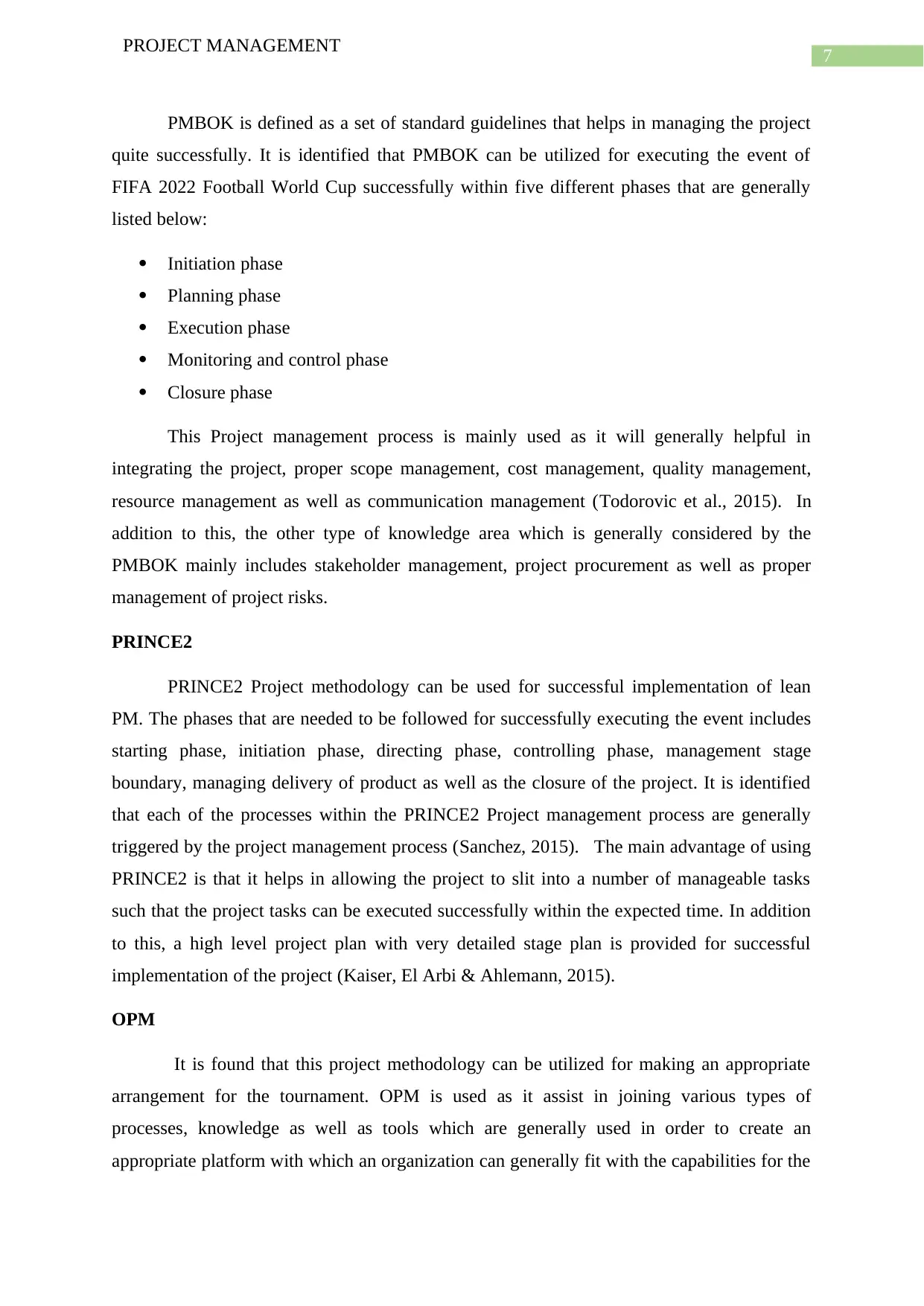
7
PROJECT MANAGEMENT
PMBOK is defined as a set of standard guidelines that helps in managing the project
quite successfully. It is identified that PMBOK can be utilized for executing the event of
FIFA 2022 Football World Cup successfully within five different phases that are generally
listed below:
Initiation phase
Planning phase
Execution phase
Monitoring and control phase
Closure phase
This Project management process is mainly used as it will generally helpful in
integrating the project, proper scope management, cost management, quality management,
resource management as well as communication management (Todorovic et al., 2015). In
addition to this, the other type of knowledge area which is generally considered by the
PMBOK mainly includes stakeholder management, project procurement as well as proper
management of project risks.
PRINCE2
PRINCE2 Project methodology can be used for successful implementation of lean
PM. The phases that are needed to be followed for successfully executing the event includes
starting phase, initiation phase, directing phase, controlling phase, management stage
boundary, managing delivery of product as well as the closure of the project. It is identified
that each of the processes within the PRINCE2 Project management process are generally
triggered by the project management process (Sanchez, 2015). The main advantage of using
PRINCE2 is that it helps in allowing the project to slit into a number of manageable tasks
such that the project tasks can be executed successfully within the expected time. In addition
to this, a high level project plan with very detailed stage plan is provided for successful
implementation of the project (Kaiser, El Arbi & Ahlemann, 2015).
OPM
It is found that this project methodology can be utilized for making an appropriate
arrangement for the tournament. OPM is used as it assist in joining various types of
processes, knowledge as well as tools which are generally used in order to create an
appropriate platform with which an organization can generally fit with the capabilities for the
PROJECT MANAGEMENT
PMBOK is defined as a set of standard guidelines that helps in managing the project
quite successfully. It is identified that PMBOK can be utilized for executing the event of
FIFA 2022 Football World Cup successfully within five different phases that are generally
listed below:
Initiation phase
Planning phase
Execution phase
Monitoring and control phase
Closure phase
This Project management process is mainly used as it will generally helpful in
integrating the project, proper scope management, cost management, quality management,
resource management as well as communication management (Todorovic et al., 2015). In
addition to this, the other type of knowledge area which is generally considered by the
PMBOK mainly includes stakeholder management, project procurement as well as proper
management of project risks.
PRINCE2
PRINCE2 Project methodology can be used for successful implementation of lean
PM. The phases that are needed to be followed for successfully executing the event includes
starting phase, initiation phase, directing phase, controlling phase, management stage
boundary, managing delivery of product as well as the closure of the project. It is identified
that each of the processes within the PRINCE2 Project management process are generally
triggered by the project management process (Sanchez, 2015). The main advantage of using
PRINCE2 is that it helps in allowing the project to slit into a number of manageable tasks
such that the project tasks can be executed successfully within the expected time. In addition
to this, a high level project plan with very detailed stage plan is provided for successful
implementation of the project (Kaiser, El Arbi & Ahlemann, 2015).
OPM
It is found that this project methodology can be utilized for making an appropriate
arrangement for the tournament. OPM is used as it assist in joining various types of
processes, knowledge as well as tools which are generally used in order to create an
appropriate platform with which an organization can generally fit with the capabilities for the
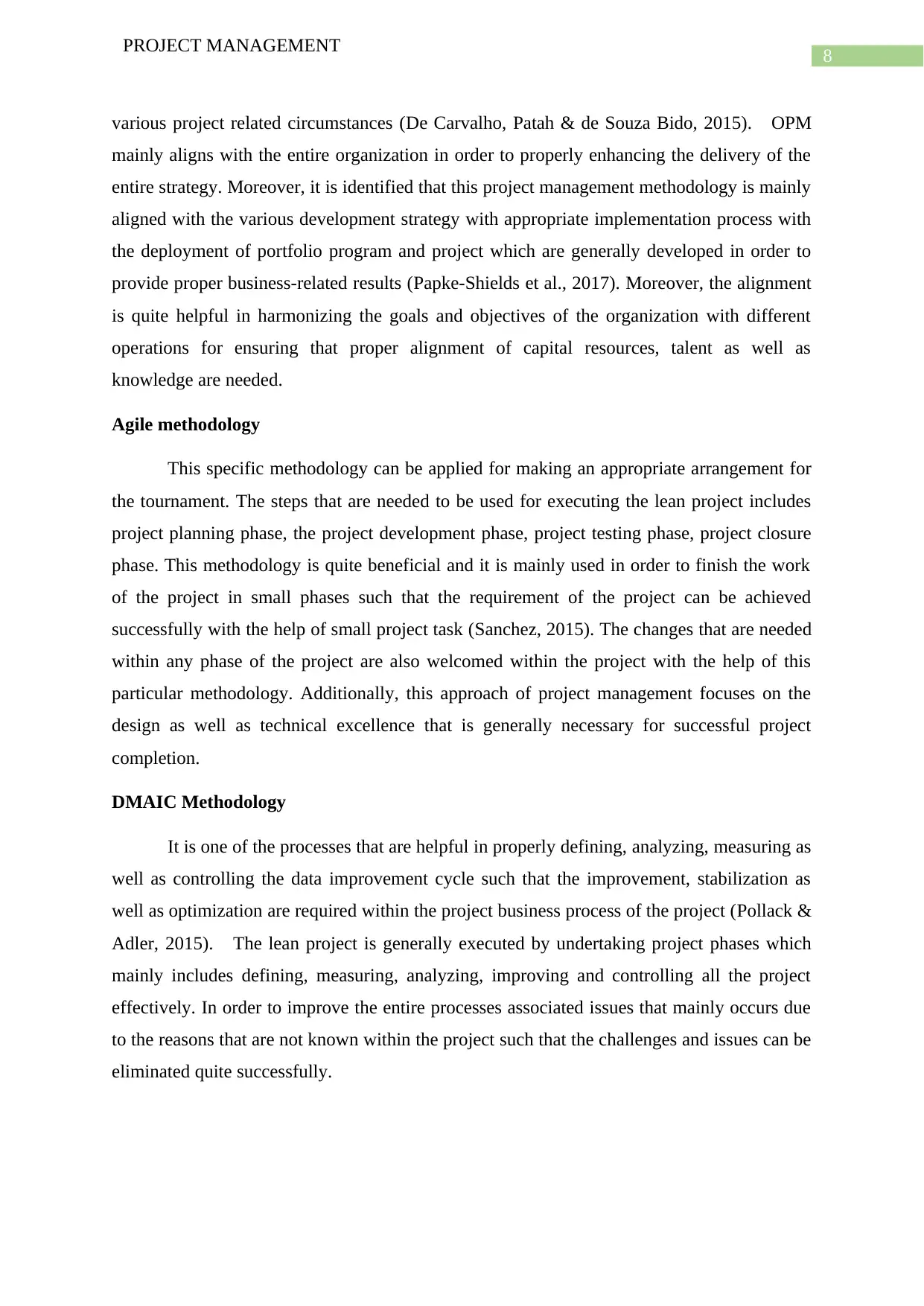
8
PROJECT MANAGEMENT
various project related circumstances (De Carvalho, Patah & de Souza Bido, 2015). OPM
mainly aligns with the entire organization in order to properly enhancing the delivery of the
entire strategy. Moreover, it is identified that this project management methodology is mainly
aligned with the various development strategy with appropriate implementation process with
the deployment of portfolio program and project which are generally developed in order to
provide proper business-related results (Papke-Shields et al., 2017). Moreover, the alignment
is quite helpful in harmonizing the goals and objectives of the organization with different
operations for ensuring that proper alignment of capital resources, talent as well as
knowledge are needed.
Agile methodology
This specific methodology can be applied for making an appropriate arrangement for
the tournament. The steps that are needed to be used for executing the lean project includes
project planning phase, the project development phase, project testing phase, project closure
phase. This methodology is quite beneficial and it is mainly used in order to finish the work
of the project in small phases such that the requirement of the project can be achieved
successfully with the help of small project task (Sanchez, 2015). The changes that are needed
within any phase of the project are also welcomed within the project with the help of this
particular methodology. Additionally, this approach of project management focuses on the
design as well as technical excellence that is generally necessary for successful project
completion.
DMAIC Methodology
It is one of the processes that are helpful in properly defining, analyzing, measuring as
well as controlling the data improvement cycle such that the improvement, stabilization as
well as optimization are required within the project business process of the project (Pollack &
Adler, 2015). The lean project is generally executed by undertaking project phases which
mainly includes defining, measuring, analyzing, improving and controlling all the project
effectively. In order to improve the entire processes associated issues that mainly occurs due
to the reasons that are not known within the project such that the challenges and issues can be
eliminated quite successfully.
PROJECT MANAGEMENT
various project related circumstances (De Carvalho, Patah & de Souza Bido, 2015). OPM
mainly aligns with the entire organization in order to properly enhancing the delivery of the
entire strategy. Moreover, it is identified that this project management methodology is mainly
aligned with the various development strategy with appropriate implementation process with
the deployment of portfolio program and project which are generally developed in order to
provide proper business-related results (Papke-Shields et al., 2017). Moreover, the alignment
is quite helpful in harmonizing the goals and objectives of the organization with different
operations for ensuring that proper alignment of capital resources, talent as well as
knowledge are needed.
Agile methodology
This specific methodology can be applied for making an appropriate arrangement for
the tournament. The steps that are needed to be used for executing the lean project includes
project planning phase, the project development phase, project testing phase, project closure
phase. This methodology is quite beneficial and it is mainly used in order to finish the work
of the project in small phases such that the requirement of the project can be achieved
successfully with the help of small project task (Sanchez, 2015). The changes that are needed
within any phase of the project are also welcomed within the project with the help of this
particular methodology. Additionally, this approach of project management focuses on the
design as well as technical excellence that is generally necessary for successful project
completion.
DMAIC Methodology
It is one of the processes that are helpful in properly defining, analyzing, measuring as
well as controlling the data improvement cycle such that the improvement, stabilization as
well as optimization are required within the project business process of the project (Pollack &
Adler, 2015). The lean project is generally executed by undertaking project phases which
mainly includes defining, measuring, analyzing, improving and controlling all the project
effectively. In order to improve the entire processes associated issues that mainly occurs due
to the reasons that are not known within the project such that the challenges and issues can be
eliminated quite successfully.
⊘ This is a preview!⊘
Do you want full access?
Subscribe today to unlock all pages.

Trusted by 1+ million students worldwide
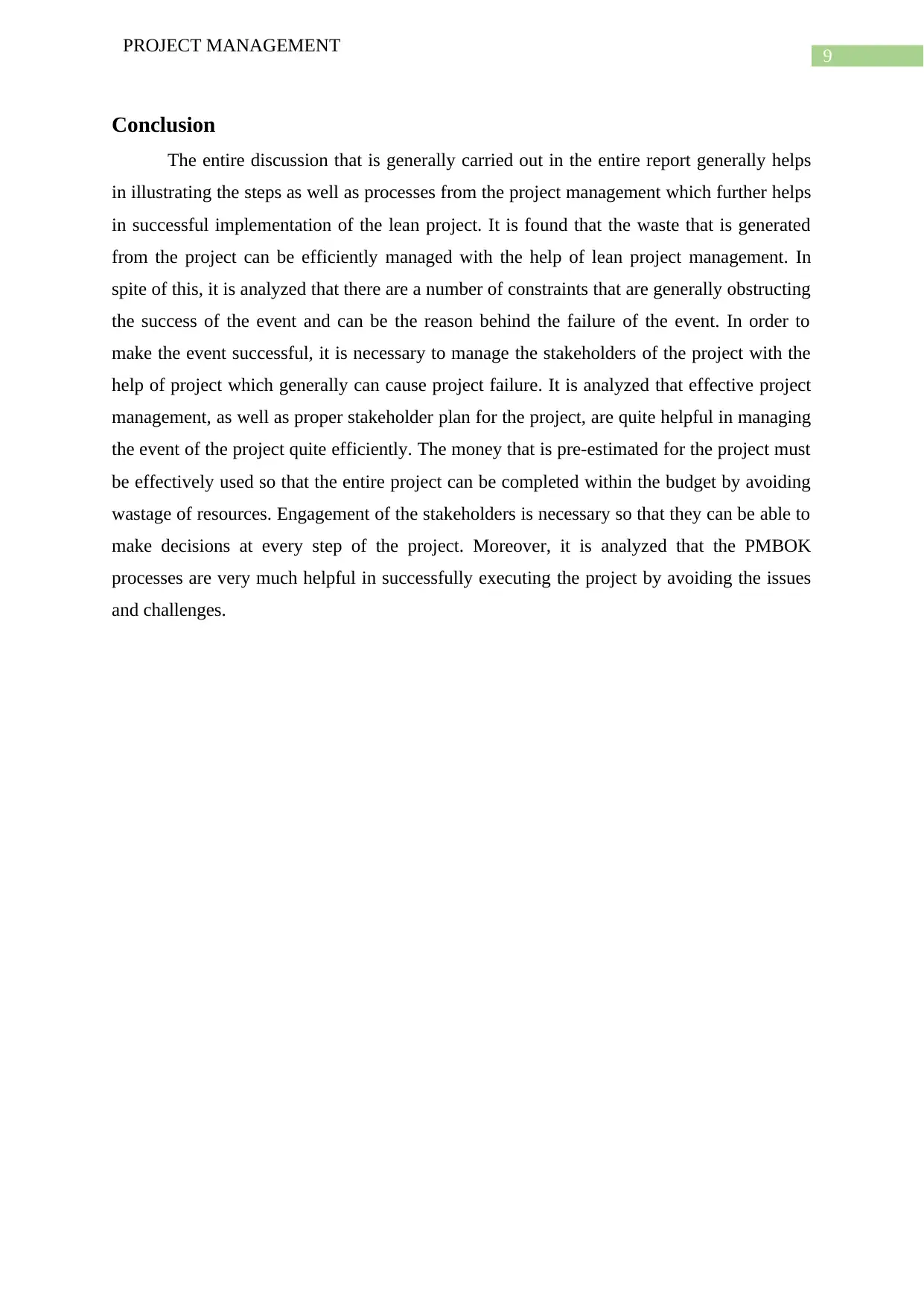
9
PROJECT MANAGEMENT
Conclusion
The entire discussion that is generally carried out in the entire report generally helps
in illustrating the steps as well as processes from the project management which further helps
in successful implementation of the lean project. It is found that the waste that is generated
from the project can be efficiently managed with the help of lean project management. In
spite of this, it is analyzed that there are a number of constraints that are generally obstructing
the success of the event and can be the reason behind the failure of the event. In order to
make the event successful, it is necessary to manage the stakeholders of the project with the
help of project which generally can cause project failure. It is analyzed that effective project
management, as well as proper stakeholder plan for the project, are quite helpful in managing
the event of the project quite efficiently. The money that is pre-estimated for the project must
be effectively used so that the entire project can be completed within the budget by avoiding
wastage of resources. Engagement of the stakeholders is necessary so that they can be able to
make decisions at every step of the project. Moreover, it is analyzed that the PMBOK
processes are very much helpful in successfully executing the project by avoiding the issues
and challenges.
PROJECT MANAGEMENT
Conclusion
The entire discussion that is generally carried out in the entire report generally helps
in illustrating the steps as well as processes from the project management which further helps
in successful implementation of the lean project. It is found that the waste that is generated
from the project can be efficiently managed with the help of lean project management. In
spite of this, it is analyzed that there are a number of constraints that are generally obstructing
the success of the event and can be the reason behind the failure of the event. In order to
make the event successful, it is necessary to manage the stakeholders of the project with the
help of project which generally can cause project failure. It is analyzed that effective project
management, as well as proper stakeholder plan for the project, are quite helpful in managing
the event of the project quite efficiently. The money that is pre-estimated for the project must
be effectively used so that the entire project can be completed within the budget by avoiding
wastage of resources. Engagement of the stakeholders is necessary so that they can be able to
make decisions at every step of the project. Moreover, it is analyzed that the PMBOK
processes are very much helpful in successfully executing the project by avoiding the issues
and challenges.
Paraphrase This Document
Need a fresh take? Get an instant paraphrase of this document with our AI Paraphraser
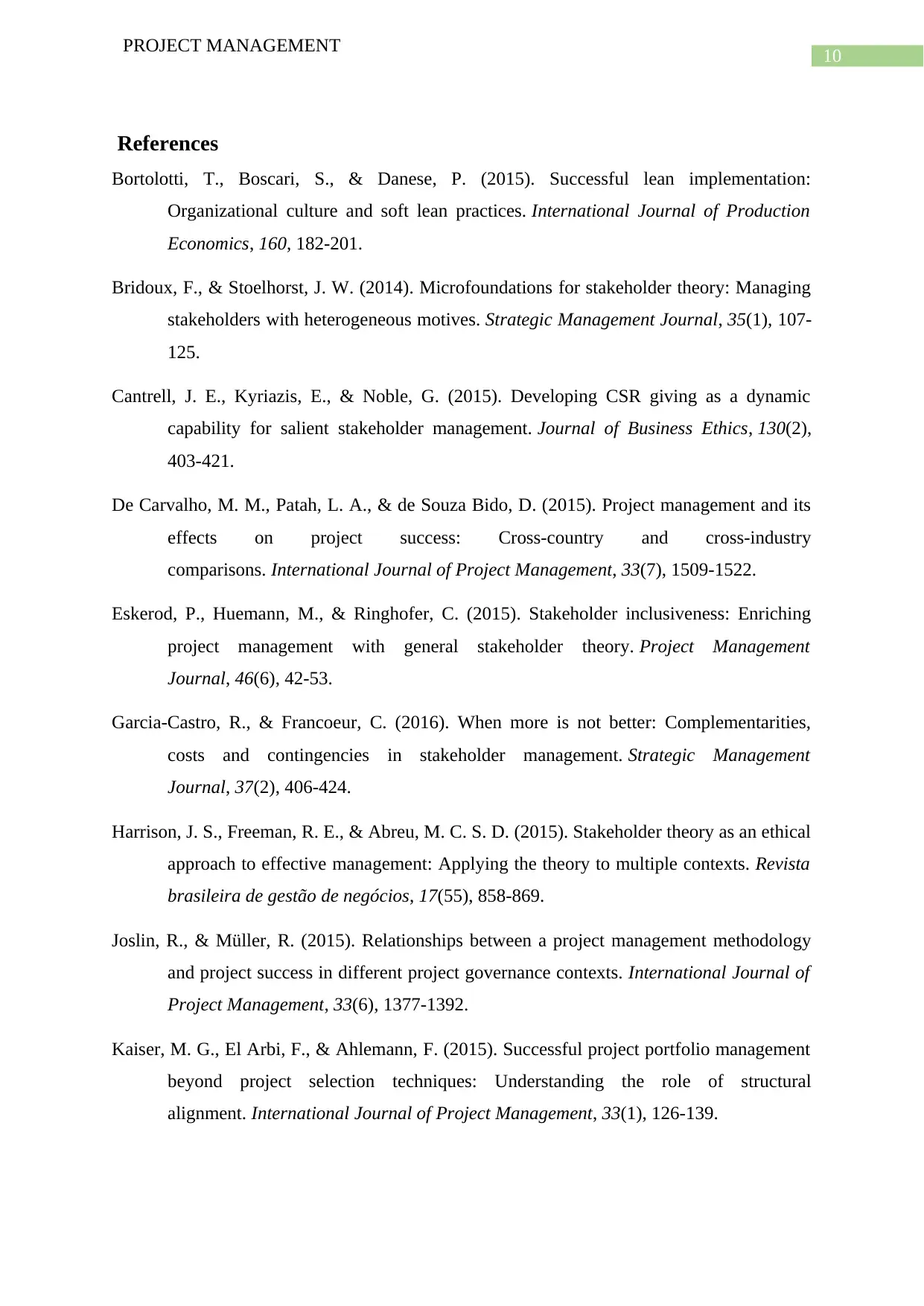
10
PROJECT MANAGEMENT
References
Bortolotti, T., Boscari, S., & Danese, P. (2015). Successful lean implementation:
Organizational culture and soft lean practices. International Journal of Production
Economics, 160, 182-201.
Bridoux, F., & Stoelhorst, J. W. (2014). Microfoundations for stakeholder theory: Managing
stakeholders with heterogeneous motives. Strategic Management Journal, 35(1), 107-
125.
Cantrell, J. E., Kyriazis, E., & Noble, G. (2015). Developing CSR giving as a dynamic
capability for salient stakeholder management. Journal of Business Ethics, 130(2),
403-421.
De Carvalho, M. M., Patah, L. A., & de Souza Bido, D. (2015). Project management and its
effects on project success: Cross-country and cross-industry
comparisons. International Journal of Project Management, 33(7), 1509-1522.
Eskerod, P., Huemann, M., & Ringhofer, C. (2015). Stakeholder inclusiveness: Enriching
project management with general stakeholder theory. Project Management
Journal, 46(6), 42-53.
Garcia‐Castro, R., & Francoeur, C. (2016). When more is not better: Complementarities,
costs and contingencies in stakeholder management. Strategic Management
Journal, 37(2), 406-424.
Harrison, J. S., Freeman, R. E., & Abreu, M. C. S. D. (2015). Stakeholder theory as an ethical
approach to effective management: Applying the theory to multiple contexts. Revista
brasileira de gestão de negócios, 17(55), 858-869.
Joslin, R., & Müller, R. (2015). Relationships between a project management methodology
and project success in different project governance contexts. International Journal of
Project Management, 33(6), 1377-1392.
Kaiser, M. G., El Arbi, F., & Ahlemann, F. (2015). Successful project portfolio management
beyond project selection techniques: Understanding the role of structural
alignment. International Journal of Project Management, 33(1), 126-139.
PROJECT MANAGEMENT
References
Bortolotti, T., Boscari, S., & Danese, P. (2015). Successful lean implementation:
Organizational culture and soft lean practices. International Journal of Production
Economics, 160, 182-201.
Bridoux, F., & Stoelhorst, J. W. (2014). Microfoundations for stakeholder theory: Managing
stakeholders with heterogeneous motives. Strategic Management Journal, 35(1), 107-
125.
Cantrell, J. E., Kyriazis, E., & Noble, G. (2015). Developing CSR giving as a dynamic
capability for salient stakeholder management. Journal of Business Ethics, 130(2),
403-421.
De Carvalho, M. M., Patah, L. A., & de Souza Bido, D. (2015). Project management and its
effects on project success: Cross-country and cross-industry
comparisons. International Journal of Project Management, 33(7), 1509-1522.
Eskerod, P., Huemann, M., & Ringhofer, C. (2015). Stakeholder inclusiveness: Enriching
project management with general stakeholder theory. Project Management
Journal, 46(6), 42-53.
Garcia‐Castro, R., & Francoeur, C. (2016). When more is not better: Complementarities,
costs and contingencies in stakeholder management. Strategic Management
Journal, 37(2), 406-424.
Harrison, J. S., Freeman, R. E., & Abreu, M. C. S. D. (2015). Stakeholder theory as an ethical
approach to effective management: Applying the theory to multiple contexts. Revista
brasileira de gestão de negócios, 17(55), 858-869.
Joslin, R., & Müller, R. (2015). Relationships between a project management methodology
and project success in different project governance contexts. International Journal of
Project Management, 33(6), 1377-1392.
Kaiser, M. G., El Arbi, F., & Ahlemann, F. (2015). Successful project portfolio management
beyond project selection techniques: Understanding the role of structural
alignment. International Journal of Project Management, 33(1), 126-139.
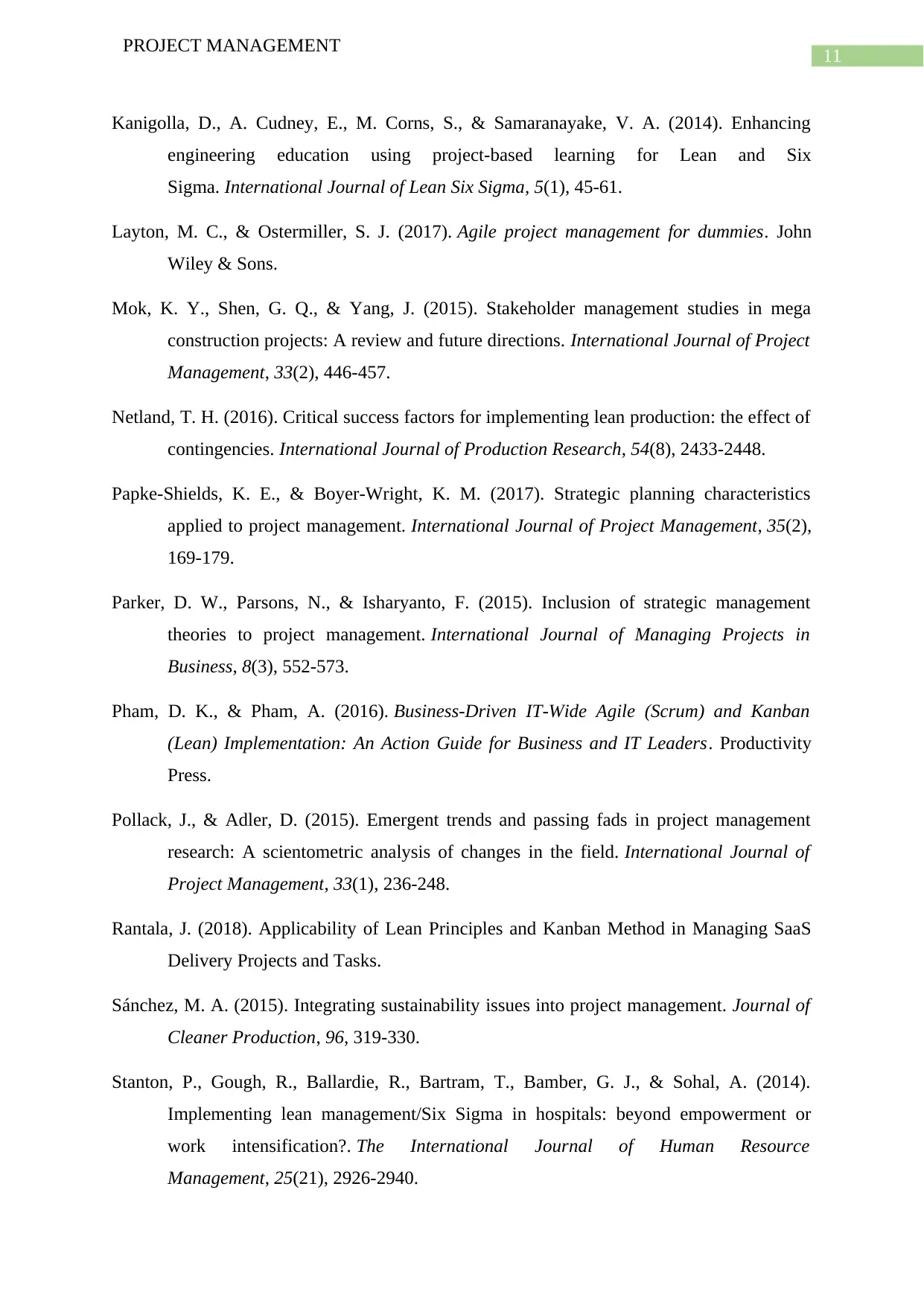
11
PROJECT MANAGEMENT
Kanigolla, D., A. Cudney, E., M. Corns, S., & Samaranayake, V. A. (2014). Enhancing
engineering education using project-based learning for Lean and Six
Sigma. International Journal of Lean Six Sigma, 5(1), 45-61.
Layton, M. C., & Ostermiller, S. J. (2017). Agile project management for dummies. John
Wiley & Sons.
Mok, K. Y., Shen, G. Q., & Yang, J. (2015). Stakeholder management studies in mega
construction projects: A review and future directions. International Journal of Project
Management, 33(2), 446-457.
Netland, T. H. (2016). Critical success factors for implementing lean production: the effect of
contingencies. International Journal of Production Research, 54(8), 2433-2448.
Papke-Shields, K. E., & Boyer-Wright, K. M. (2017). Strategic planning characteristics
applied to project management. International Journal of Project Management, 35(2),
169-179.
Parker, D. W., Parsons, N., & Isharyanto, F. (2015). Inclusion of strategic management
theories to project management. International Journal of Managing Projects in
Business, 8(3), 552-573.
Pham, D. K., & Pham, A. (2016). Business-Driven IT-Wide Agile (Scrum) and Kanban
(Lean) Implementation: An Action Guide for Business and IT Leaders. Productivity
Press.
Pollack, J., & Adler, D. (2015). Emergent trends and passing fads in project management
research: A scientometric analysis of changes in the field. International Journal of
Project Management, 33(1), 236-248.
Rantala, J. (2018). Applicability of Lean Principles and Kanban Method in Managing SaaS
Delivery Projects and Tasks.
Sánchez, M. A. (2015). Integrating sustainability issues into project management. Journal of
Cleaner Production, 96, 319-330.
Stanton, P., Gough, R., Ballardie, R., Bartram, T., Bamber, G. J., & Sohal, A. (2014).
Implementing lean management/Six Sigma in hospitals: beyond empowerment or
work intensification?. The International Journal of Human Resource
Management, 25(21), 2926-2940.
PROJECT MANAGEMENT
Kanigolla, D., A. Cudney, E., M. Corns, S., & Samaranayake, V. A. (2014). Enhancing
engineering education using project-based learning for Lean and Six
Sigma. International Journal of Lean Six Sigma, 5(1), 45-61.
Layton, M. C., & Ostermiller, S. J. (2017). Agile project management for dummies. John
Wiley & Sons.
Mok, K. Y., Shen, G. Q., & Yang, J. (2015). Stakeholder management studies in mega
construction projects: A review and future directions. International Journal of Project
Management, 33(2), 446-457.
Netland, T. H. (2016). Critical success factors for implementing lean production: the effect of
contingencies. International Journal of Production Research, 54(8), 2433-2448.
Papke-Shields, K. E., & Boyer-Wright, K. M. (2017). Strategic planning characteristics
applied to project management. International Journal of Project Management, 35(2),
169-179.
Parker, D. W., Parsons, N., & Isharyanto, F. (2015). Inclusion of strategic management
theories to project management. International Journal of Managing Projects in
Business, 8(3), 552-573.
Pham, D. K., & Pham, A. (2016). Business-Driven IT-Wide Agile (Scrum) and Kanban
(Lean) Implementation: An Action Guide for Business and IT Leaders. Productivity
Press.
Pollack, J., & Adler, D. (2015). Emergent trends and passing fads in project management
research: A scientometric analysis of changes in the field. International Journal of
Project Management, 33(1), 236-248.
Rantala, J. (2018). Applicability of Lean Principles and Kanban Method in Managing SaaS
Delivery Projects and Tasks.
Sánchez, M. A. (2015). Integrating sustainability issues into project management. Journal of
Cleaner Production, 96, 319-330.
Stanton, P., Gough, R., Ballardie, R., Bartram, T., Bamber, G. J., & Sohal, A. (2014).
Implementing lean management/Six Sigma in hospitals: beyond empowerment or
work intensification?. The International Journal of Human Resource
Management, 25(21), 2926-2940.
⊘ This is a preview!⊘
Do you want full access?
Subscribe today to unlock all pages.

Trusted by 1+ million students worldwide
1 out of 13
Related Documents
Your All-in-One AI-Powered Toolkit for Academic Success.
+13062052269
info@desklib.com
Available 24*7 on WhatsApp / Email
![[object Object]](/_next/static/media/star-bottom.7253800d.svg)
Unlock your academic potential
Copyright © 2020–2025 A2Z Services. All Rights Reserved. Developed and managed by ZUCOL.





